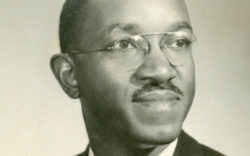Emmett Till
Sixty-one years ago this month, a Tallahatchie County, Mississippi, jury acquitted Roy Bryant and J. W. Milam despite a pile of damning evidence that the two had abducted, beaten, and then shot Emmett Till, a young Chicagoan scarcely a month past his fourteenth birthday, for violating a strict racial taboo by whistling at Bryant’s wife. Since that day, the Emmett Till case has often been cited as both a catalyst for the Civil Rights movement and, more recently, as a trigger for black mobilization on a scale comparable to the “Black Lives Matter” movement. Understandable as they might be, these leaps to conclusions and connections simply don’t square with either historical or contemporary reality.
After Emmett’s body was fished from the Tallahatchie River, with his neck bound by barbed wire to a cotton gin fan, his mother, Mamie Till Bradley, was determined to let “the world see what they had done to my boy” and insisted on an open-casket funeral which revealed a corpse so horribly bloated and bludgeoned that it was barely recognizable as human. Not only did tens of thousands of mourners in Chicago file by the horrific sight in the casket, but when Jet Magazine ran an exclusive photograph of Emmett Till’s battered and bloated head, that issue sold out so quickly that more copies were printed, and the photo ran the following week as well. The trial itself drew coverage from the major television networks and more than seventy reporters and photographers, representing such major print outlets as the New York Times, Life, Look, and Time, and several black newspapers and magazines and a sprinkling of foreign publications as well.

The trial proceedings offered a real-life template for a fictional southern courtroom drama straight out of central casting, complete with a big-bellied sheriff spewing racial epithets and a defense attorney who exhorted an all-white jury in a 63 percent black county to do their “Anglo-Saxon” duty by freeing the defendants. Compounding the affront to justice, in January 1956, Look Magazine published a story in which Bryant and Milam, their tongues loosened by a nice paycheck and the shield of double jeopardy, admitted to the crime, with Milam explaining coldly he had decided to “make an example” of young Emmett “just so everbody [sic] can know how me and my folks stand.”
Yet, even after singer Nat Cole was brutally beaten onstage by Klansmen in Birmingham a few months later, neither the television networks or major U.S. papers like the New York Times chose to make southern racial violence a focal point, and with Cold War anxieties rendering social agitation seriously suspect, a year after Emmett’s slaying scarcely 6 percent of Gallup Poll respondents outside the South thought civil rights was the nation’s most pressing issue. Meanwhile, fearful of a savage backlash from white southerners, television executives forced award-winning screenwriter and “Twilight Zone” creator Rod Serling to eviscerate not one but two screenplays (the first in 1956 and another 1958) based on the Emmett Till story by cutting out any reference or suggestion of southern settings, characters, or racial practices before they were aired.
If John Egerton was correct in observing that while the Till case “stirred the nation’s conscience momentarily, the attention span was short and the South slipped back into the shadows,” what of its supposed catalytic effect on the crusade to end racial injustice? It was true enough that when questioned about it, Rosa Parks admitted that thinking of poor Emmett had strengthened her resolve in the three-month interval between his death and her act of defiance that sparked the Montgomery Bus Boycott in December 1955. Yet plans for such an action had not only been in the works well before Till’s slaying, but were modeled on a similar boycott by blacks in Baton Rouge two years earlier. NAACP leaders in Mississippi and elsewhere were also filing petitions for compliance with the Brown decision before Till’s murder.
While the adult generation of black activists were vividly familiar with the South’s long history of racial atrocities, their children, especially those in Emmett’s age group, were much more vulnerable to the horrors of the Till affair, especially the terrifying casket photo so jealously guarded by Jet that few of their white peers ever saw it. Young Cleveland Sellers could not shake the feeling that the ghastly figure in the casket “could have been me or any other black kid around that same age,” They were only teenagers in 1955, but it was surely no coincidence that, when a new decade dawned with less than 1 percent of school-age southern black children in integrated classrooms and southern black voter registration only 4 percent higher than it had been in 1956, it was four frustrated members of the Till generation who boldly took seats at an all-white lunch counter in Greensboro in 1960. This action, in turn, helped to spawn the Student Non-Violent Coordinating Committee whose more aggressive and confrontational approach attracted a number of Till’s peers, including Sellers and Joyce Ladner, who could easily identify “10 SNCC workers who saw that picture [of Till’s body] in Jet magazine, [and] remember it as the key thing about their youth that was emblazoned in their minds.”
Instead of an immediate and dramatic spark for black activism, the Emmett Till tragedy proved more akin to a seed pod, which, at maturity, released a deferred but timely burst of pent-up energy and anger from a young adult generation whose adolescence had been taken hostage by fear. Current concerns about an extended spate of controversial killings of black Americans have stirred several well-known filmmakers to revisit the Till story. This is welcome news, especially if they resist such facile comparisons as likening the impact of the 1955 murder of Emmett Till to that of the 2014 Ferguson, Missouri slaying of Michael Brown, which is seen as triggering the “Black Lives Matter” movement, on the grounds that “both events galvanized a black community that had been unheard and spawned movements around what many saw as particularly egregious racial incidents.” In reality, the Black Lives Matter campaign testifies to nothing so much as the hard-won advances in black, political, social, economic, and technological empowerment that have marked the last three generations. Such a rapid, aggressive, coordinated and broad-based response would have been unthinkable to black leaders struggling in the 1950s to mobilize their impoverished, disfranchised, uneducated, and historically brutalized constituencies in an era of virtually unchecked racial terrorism when, by any valid measure, black lives mattered far less than they do today.
*A modified version of this essay appeared under a different title on time.com.
Like what you just read? Support Flagpole by making a donation today. Every dollar you give helps fund our ongoing mission to provide Athens with quality, independent journalism.










